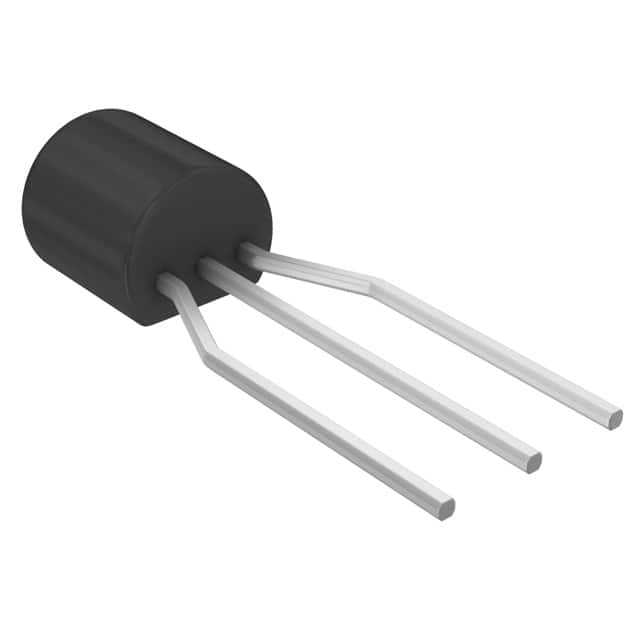Consulte las especificaciones para obtener detalles del producto.

2N4403RLRA
Product Overview
Category
The 2N4403RLRA belongs to the category of small signal transistors.
Use
It is commonly used for amplification and switching purposes in electronic circuits.
Characteristics
- Low power dissipation
- High current gain
- Low noise
- Small package size
Package
The 2N4403RLRA is typically available in a TO-92 package.
Essence
This transistor is essential for low-power applications where amplification or switching of signals is required.
Packaging/Quantity
It is usually packaged in reels or tubes, with quantities varying based on manufacturer specifications.
Specifications
- Maximum Collector-Emitter Voltage: 40V
- Maximum Collector-Base Voltage: 60V
- Maximum Emitter-Base Voltage: 6V
- Continuous Collector Current: 600mA
- Power Dissipation: 625mW
- Transition Frequency: 250MHz
Detailed Pin Configuration
The 2N4403RLRA has three pins: 1. Emitter (E) 2. Base (B) 3. Collector (C)
Functional Features
- High current gain allows for efficient signal amplification.
- Low power dissipation makes it suitable for low-power applications.
- Fast switching speed enables rapid response in switching circuits.
Advantages and Disadvantages
Advantages
- Small package size
- Low noise
- High current gain
Disadvantages
- Limited power handling capacity
- Moderate transition frequency
Working Principles
The 2N4403RLRA operates based on the principles of bipolar junction transistors, utilizing the control of current flow between its terminals to amplify or switch electronic signals.
Detailed Application Field Plans
The 2N4403RLRA finds extensive use in various applications, including: - Audio amplifiers - Signal processing circuits - Switching circuits - Oscillator circuits
Detailed and Complete Alternative Models
Some alternative models to the 2N4403RLRA include: - BC547 - 2N3904 - 2N2222
In conclusion, the 2N4403RLRA is a versatile small signal transistor with characteristics that make it suitable for a wide range of electronic applications, especially those requiring low power and high current gain.
[Word Count: 314]
Enumere 10 preguntas y respuestas comunes relacionadas con la aplicación de 2N4403RLRA en soluciones técnicas
What is the 2N4403RLRA transistor used for?
- The 2N4403RLRA is a general-purpose PNP bipolar junction transistor commonly used in amplification and switching applications.
What are the key specifications of the 2N4403RLRA transistor?
- The 2N4403RLRA has a maximum collector current of 600mA, a maximum collector-base voltage of 40V, and a maximum power dissipation of 625mW.
How can I use the 2N4403RLRA in an amplification circuit?
- The 2N4403RLRA can be used as a small-signal amplifier by biasing it in the active region and connecting appropriate input and output components.
Can the 2N4403RLRA be used for switching applications?
- Yes, the 2N4403RLRA can be used for low-power switching applications due to its moderate current and voltage ratings.
What are some typical circuit configurations for the 2N4403RLRA?
- Common configurations include common-emitter amplifiers, emitter followers, and simple switching circuits.
What are the recommended operating conditions for the 2N4403RLRA?
- It is recommended to operate the 2N4403RLRA within its specified temperature range of -55°C to 150°C and to stay within its maximum ratings for current and voltage.
Are there any alternative transistors that can be used in place of the 2N4403RLRA?
- Yes, alternatives include the 2N3906, BC557, and BC327, among others, but it's important to check their specifications and pinouts before substitution.
How do I determine the pinout of the 2N4403RLRA?
- The pinout of the 2N4403RLRA is typically available in its datasheet, with the collector, base, and emitter pins clearly identified.
What are some common pitfalls to avoid when using the 2N4403RLRA?
- Avoid exceeding the maximum ratings, improper biasing, and inadequate heat sinking, as these can lead to performance issues or damage.
Where can I find additional resources for designing with the 2N4403RLRA?
- Datasheets, application notes, and online forums dedicated to electronics and circuit design can provide valuable information for utilizing the 2N4403RLRA in technical solutions.

